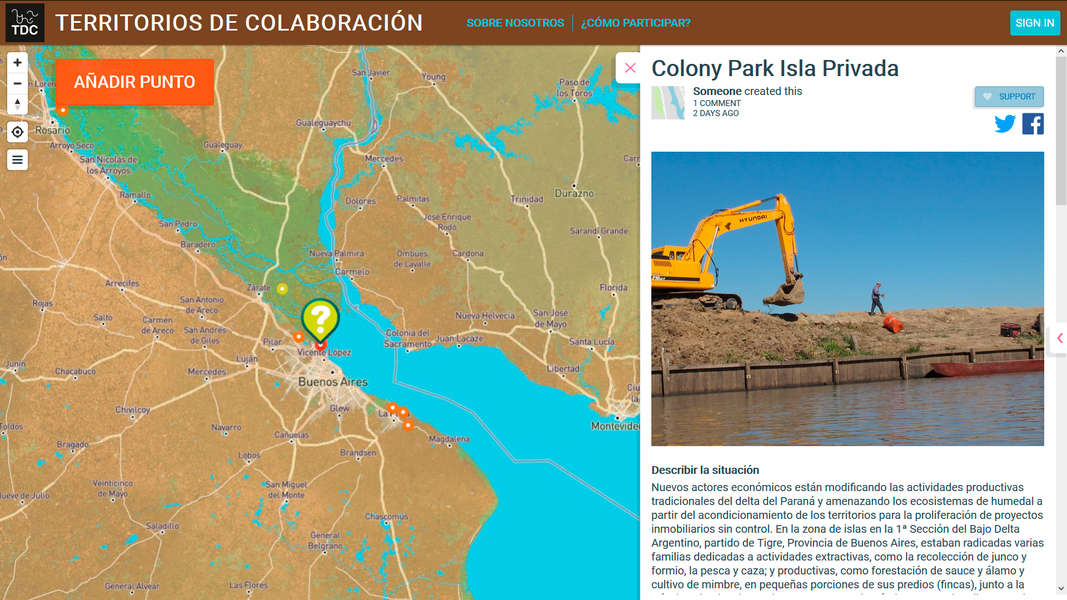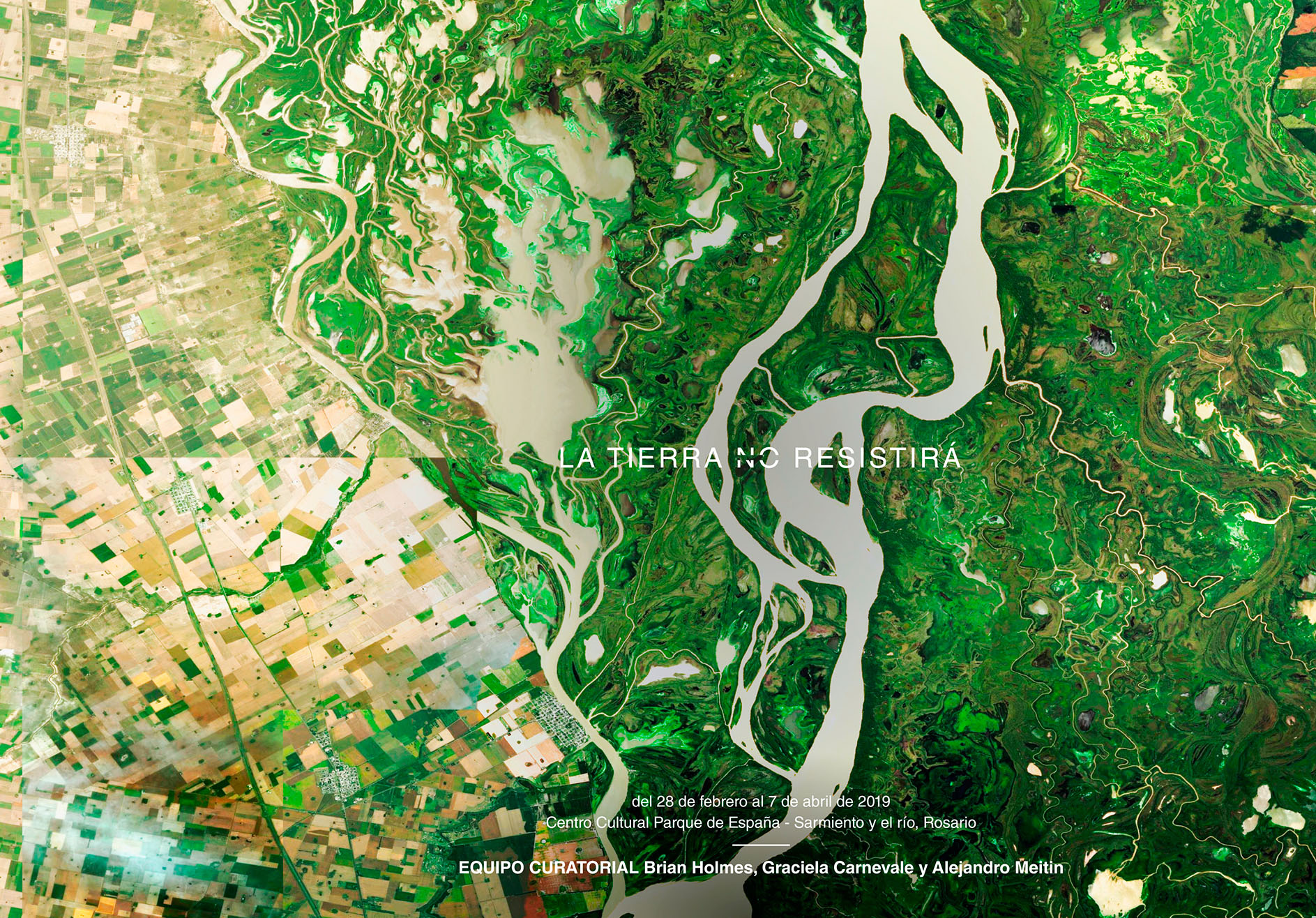The Earth Will Not Abide is an exhibition of critical geography that aims to explore the symbiotic community of the soil and its destinies in the age of globalized industrial agriculture. Collaborative Territories is an initiative that responds to the threat of total environmental control by engaging in expressive solidarities with the island-dwellers of the Delta. The meeting of the two is hardly an accident, because the central goal of The Earth Will Not Abide was to explore the changes in land use brought on by GMO agriculture plus the new China market, which together have sparked huge expansions of the grain-growing frontier, both in North and in South America.
The video entitled “A Great Green Desert,” by Ryan Griffis and Sarah Ross, compares scenes from monocrop fields in Illnois and Brazil, in such a way that you often cannot tell the difference. That’s because the underlying processes of colonization are so inherently similar. The wall display and web-based map/archive, “Open Veins of the Americas,” by myself and Alejandro Meitin, explores the “Living Rivers” of the Mississippi and Parana watersheds, which are both major industrial river basins exporting grain. The theme of the symbiotic soil community and its relation to industrial farming is developed in the soil chromatography by Claire Pentecost, and in a somewhat different way, in the delirious “Cornstitution” translated from the language of the Maize by Sarah Lewison and duskin drum. Finally, the conflict between traditional peasant life and financially driven modernization processes is raised, not in South America, but instead in the soy-importing country of China. Sarah Lewison’s three-channel video “Naxilandia” deals with everyday peasant resistance to modernization in the Lashihai Valley in the Chinese province of Kunming.
The Argentinean edition of the show is quite different from the three previous versions that were held at the University of Illinois at Chicago, at Southern Illinois University in Carbondale, and at the Pacific Northwest College of Art in Portland. The difference is simple to explain: we sent out a powerful message from the North, and we got a transformative response from the South, fulfilling and exceeding the potential spaces left vacant in our work. Graciela Carnevale and Alejandro Meitin organized, not only the exhibition in Rosario, but much more: five “campaigns” that sent artists, activist researchers and local inhabitants out into the island territories of the Delta, and then subsequently brought the same heterogeneous mix of people together again to elaborate aesthetic expressions of their experiments in collective perception. The formalization process of these experiences was particularly interesting, socially, geographically, ecologically – a real intensive mix that delves deep into each particular territory. The results of the five campaigns were combined with works by Eduardo Molinari and Santiago Fredes, as well as small retrospective sections devoted to multiple antecedents, including the CuencasLab program in 2015 which Sarah Lewison and I were fortunate enough to join along with Critical Art Ensemble (eternal thanks to CAE). Finally I should add that all this was correlated with support for a very concrete objective endorsed by everyone participating, namely the passage of a “Wetlands Law” that would provide a conservation framework for riverine environments in Argentina, including their human dwellers and not just a fantasy of pristine nature.
The closed two-day meeting that followed the opening was an organizational interweave of around forty people, involving NGO representatives, environmentalists, local political figures, artists, island-dwellers, people chased off their land by gated communities and a project on the “Feminist River” that comes straight out of a rising national social movement (however all but one of them chose not to come to the event). In contemporary art circles there used to be a lot of value placed what Felix Guattari called “transversality,” which referred to social and political initiatives mixing people of different outlooks, origins, languages, social classes, skin colors and genders, in such a way that the differences resonate far beyond the statistical sum of diverse parts. These kinds of things are never smooth or easy, but I am glad to be doing them again.

“Convoking multiple perspectives on the Parana River Delta, The Earth Will Not Abide asks a question at the scale of the Western hemisphere: How to protect vital ecosystems against the devastation of extractive agriculture? How to escape the standardizing process that is transforming landscapes throughout the Americas?
“The exhibition in Rosario comes out of a collaboration with artists from in and around Chicago: two cities at the center of the global grain trade, each surrounded by a ‘great green desert.’ In the Mississippi basin, as in the La Plata watershed, endless fields of genetically modified crops are causing increasing levels of environmental damage while contributing significantly to climate change. The works presented in the final room of the exhibition draw striking parallels between North and South, showing how living soil is reduced to a simple substrate for chemical products. Even in China, the largest of the soy-importing countries, the transformation of the territory mixes modernization and threat: two sides of the same coin, whose economic laws regulate our planet’s destiny.
“Faced with this critical assessment, an emerging movement composed of artists, researchers and inhabitants of the Rio de la Plata Delta have begun ‘learning from the flood,’ letting themselves be guided by the shape-shifting territory of the wetlands. Five groups, each mixing different horizons, set out for experiments in collective perception along the river’s braided channels, from Rosario and Victoria near the Delta’s northern tip, to Isla Paulino on the south bank of the estuary. Using an interactive map to leave traces of their passage, and adding their new work to previous iterations of the Delta project, these groups translate their perceptions into visual and acoustic forms, creating a flourishing ‘culture diversity’ in tune with the amazing biodiversity of the riverine environment.
“How to move from away the current pattern of agrochemical exploitation, toward a new coexistence with nature? The expressions gathered in this exhibition give a foretaste of future social conflicts, when humans and non-humans will come together to resist the forces that are denying everyone’s right to residence on Earth.”
***
For further information about The Earth Will Not Abide, see http://regionalrelationships.org/tewna
For a look into the projects organized by Alejandro Meitin and a wide range of collaborators, see https://www.casariolab.art
For visitor information see the website of Centro Cultural Parque de Espana: http://ccpe.org.ar
Finally, if you have not checked out Rios Vivos/Living Rivers, you can see that at http://ecotopia.today/riosvivos/mapa.html (and don’t forget to hit the “North” button if you want some English).



One thought on “The Earth Will Not Abide / Collaborative Territories”